#dress history book
Photo

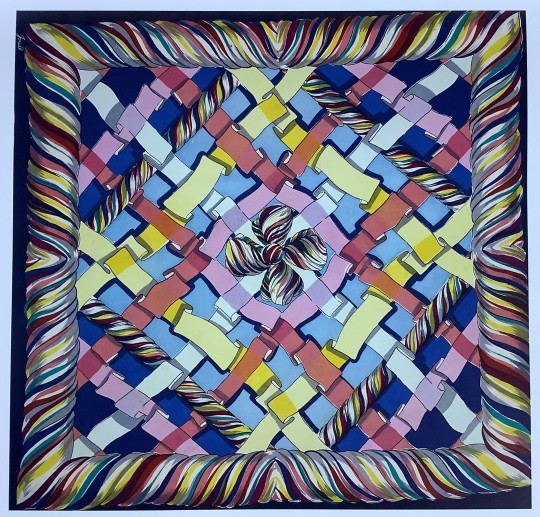


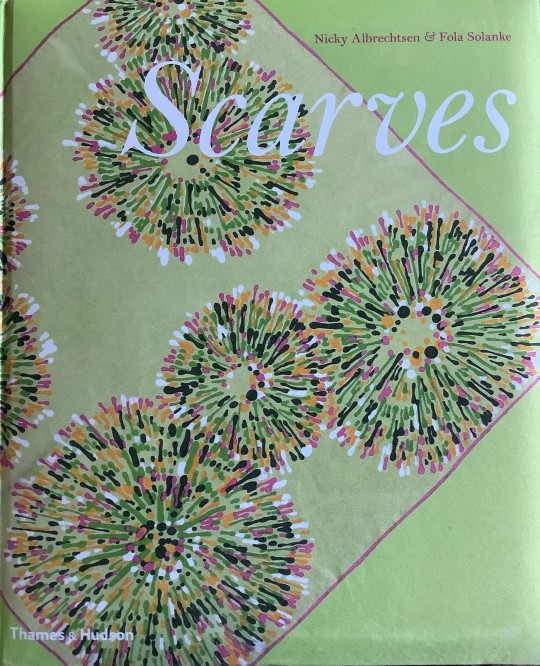
A Big Beautiful Book: Scarves by Nicky Albrechtsten and Fola Solanke
The cover of this book is a textile itself which you kind of wish you could take off and wear. It signals that this big coffee table book offers hundreds of large images of scarves organized by themes like eras, artists, textile designers, scarf companies, etc. Each offers a short essay, but the real treats are the pictures. The images remind us of the extraordinary creativity that went into this accessory over the course of the 20th Century.
You see here the lovely palette called “Vermillion” in silk twill by textile designer Georgina von Etzdorf. Then a ribbon scarf from the 1940s whose designer is unknown and whose color play charmed me. Then two scarves from the 1950s: a rayon travel scarf from the 1950s on Manhattan, bought to mark a trip, from a chapter on travel scarves, and then a Liberty silk scarf which seems to be playing with the TV antennas that proliferated in that decade. It has a strangely technological look.
While we can appreciate the scarves laid out flat like this, their real appeal is how they will look tied around the neck or shoulders. That is when the colors themselves make an outfit. While today we see a super-abundance of cowls, I am far more keen on scarves myself. If you take a look at this book, you will understand why.
You can find it here: https://thamesandhudson.com/scarves-9780500296172
#thames and hudson#scarves#vintage scarves#1930s fashions#1940s fashions#1950s fashions#1960s fashions#georgina von etzdorf#liberty of london#travel scarves#vintage accessories#silk scarves#costume history#dress history#fashion history#fashion history book#dress history book#costume history book#nicky albrechtsen#fola solanke
14 notes
·
View notes
Text
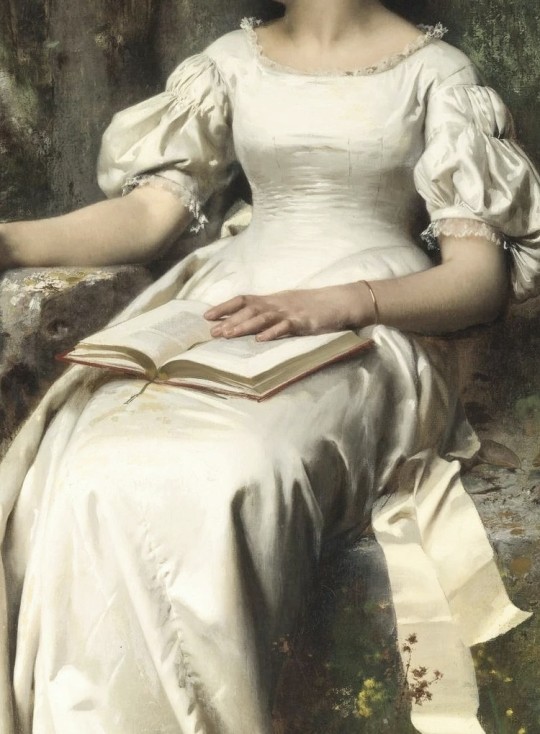
Léon Bazile Perrault
French, 1832-1908
Meditation (detail)
#Art#painting#classical art#léon bazile perrault#art detail#french art#fine arts#paintings#painting detail#light academia aesthetic#light academia#art#women in art#19th century fashion#19th century art#art history#white dress#books
2K notes
·
View notes
Note
I've seen a post you've reblogged and added to, among many things about women showing nipples. Can you recommend any ref material (articles, videos, etc.) are share your knowledge about this? Cause I'm curious about that, as nowadays going out in a shirt without a bra makes you indecent, while in like 90s it was okayish? I wonder how it was in previous centuries.
There is a really cool academic paper about bare breast dresses in 17th century England specifically. I think anyone can read it by creating a free account.
Abby Cox also has a good video about the cleavage during the past 500 years in which she goes through also the nip slip phenomena.
I don't have other sources that specifically focus on this subject, though many sources about specific decades touch on it, but I do have my primary source image collection, so I can sum up the history of the bare nipple.
So my findings from primary source images (I could be wrong and maybe I just haven't found earlier examples) is that the Venetians were the first ones to show the nipple for courtly fashion. At the same time in other places in Europe they sported the early Elizabethan no-boob style that completely covered and flattened the chest. In the other corners of Italy the necklines were also low but less extreme. Venetian kirtle necklines dropped extremely low as early as 1560s and they combined extremely sheer, basically see-through partlets with their kirtle. First example below is a 1565-70 portrait of a Venetian lady with the nipples just barely covered waiting slip into view with a movement of arm. There was an even more extreme version of this with the kirtle being literally underboob style, still with a sheer doublet. Though I believe this was not quite for the respectable ladies, since I have only seen it depicted on high class courtesans. They were not exactly respectable ladies, but they did have quite good social position. The second example is a 1570s depiction of a courtesan, which is revealed by the horned hairstyle. By the end of the century this underbust style with only see through fabric covering breasts, had become respectable. In the last example it's shown on the wife of the Venetian doge in 1597.
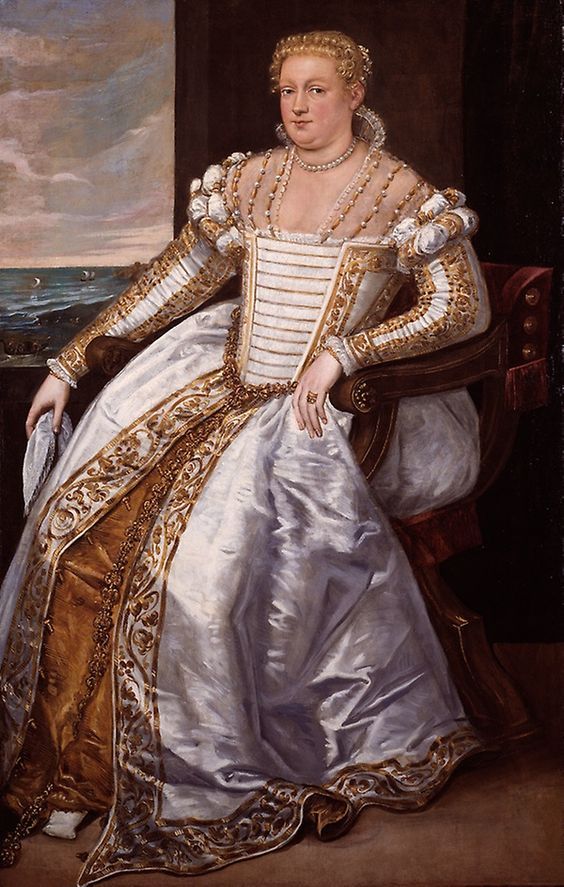
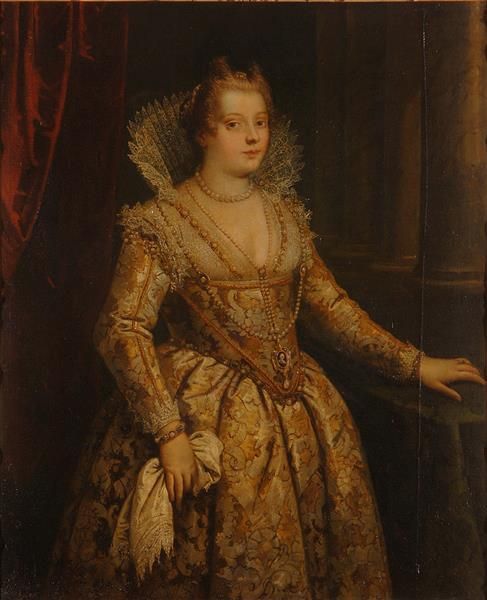

Around the same time, at the very end of 1500s, the extremely low cut bodice fashion enters rest of Europe. The low cut style was present in the bodices of all classes, but the nipple was really only an aristocrat thing. The lower classes would cover their breasts with a partlet, that was not sheer. Bare breast was ironically from our perspective a show of innocence, youthful beauty and virtue, and to pull off the style with respect, you also had to embody those ideals. Lower class women were considered inherently vulgar and lacking virtue, so a nipple in their case was seen as indecent. Bare boobs were also a sort of status symbol, since the upper class would hire wet nurses to breastfeed their children so they could show of their youthful boobs.
Covering partlets and bodices were still also used in the first decade of 1600s by nobles and the nip slip was mostly reserved for the courtly events. The first image below is an early example of English extremely low neckline that certainly couldn't contain boobs even with a bit of movement from 1597. The 1610s started around 5 decades of fashion that showed the whole boob. The first three were the most extreme. Here's some highlights: The second image is from 1619.
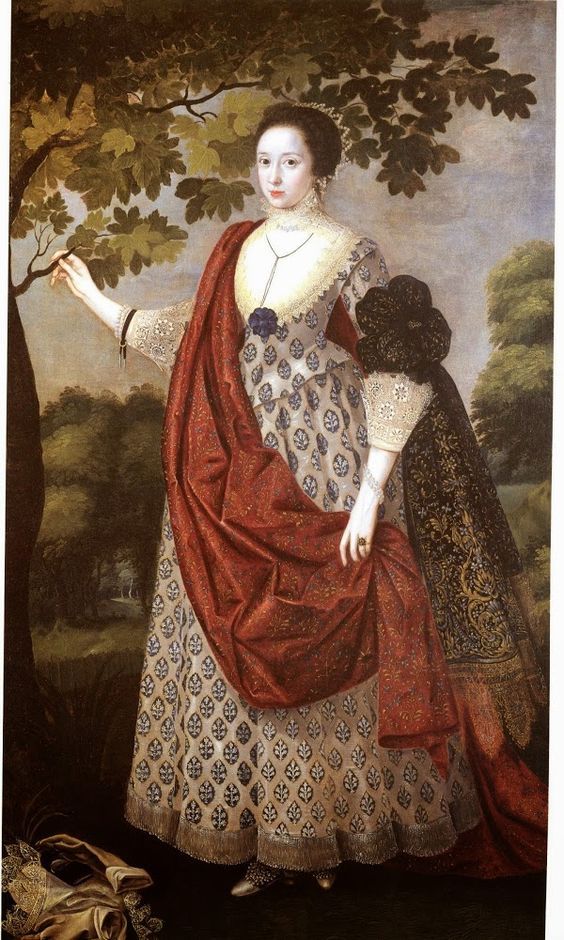

Here the first, very much showing nipples, from c. 1630. The second from 1632.
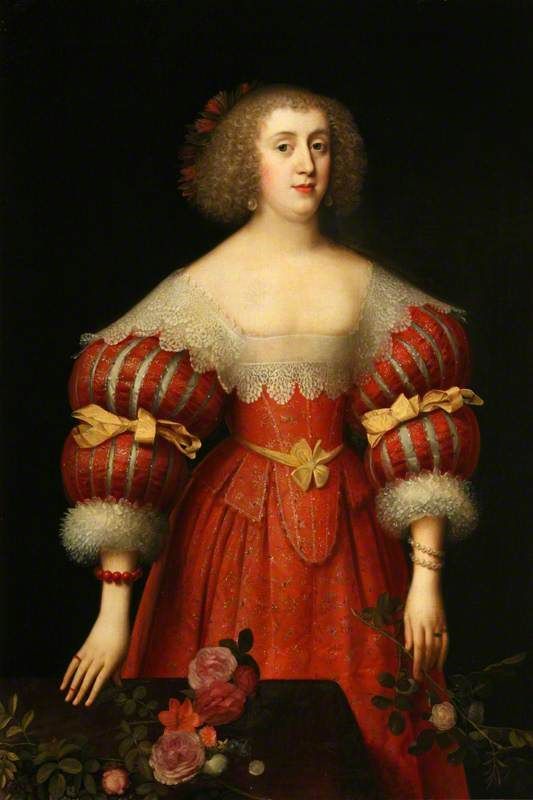
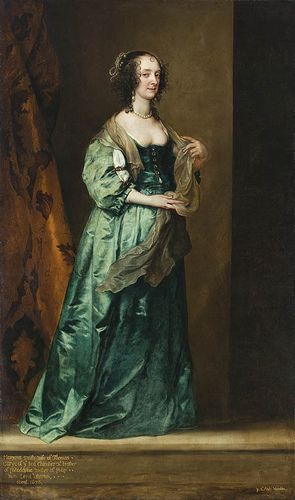
The neckline would slowly and slightly rise during the next decades, but nip slips were still expected. Here's an example from 1649 and then from 1650-55. In 1660s the neckline would get still slightly higher and by 1870s it was in a not very slippable hight. The necklines would stay low for the next century, though mostly not in boob showing territory, but we'll get there. But I will say that covering the neckline in casual context was expected. Boobs were mostly for fancy occasions. It was considered vain to show off your boobs when the occasion didn't call for it and covering up during the day was necessary for a respectable lady. You wouldn't want to have tan in your milk-white skin like a poor, and also they didn't have sun screen so burning was a reasonable concern.

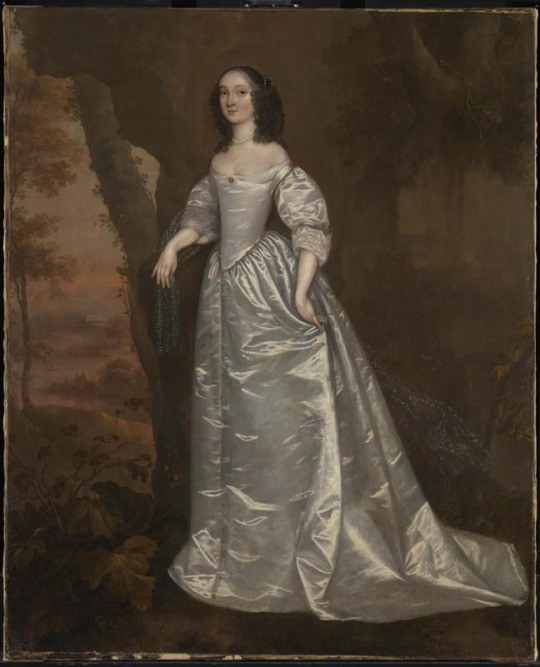
1720s to 1740s saw necklines that went to the nip slip territory, though they didn't go quite as low as 100 years earlier. The nipple was present in the French courtly fashion especially and rouging your nipples to enhance them was popular. Émilie Du Châtelet (1706-1749), who was an accomplished physicist and made contributions to Newtonian mechanics, was known in the French court to show off her boobies. An icon. Here she is in 1748. Here's another example from this era from 1728.
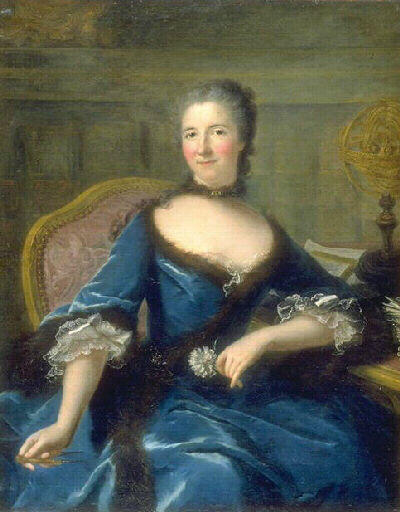
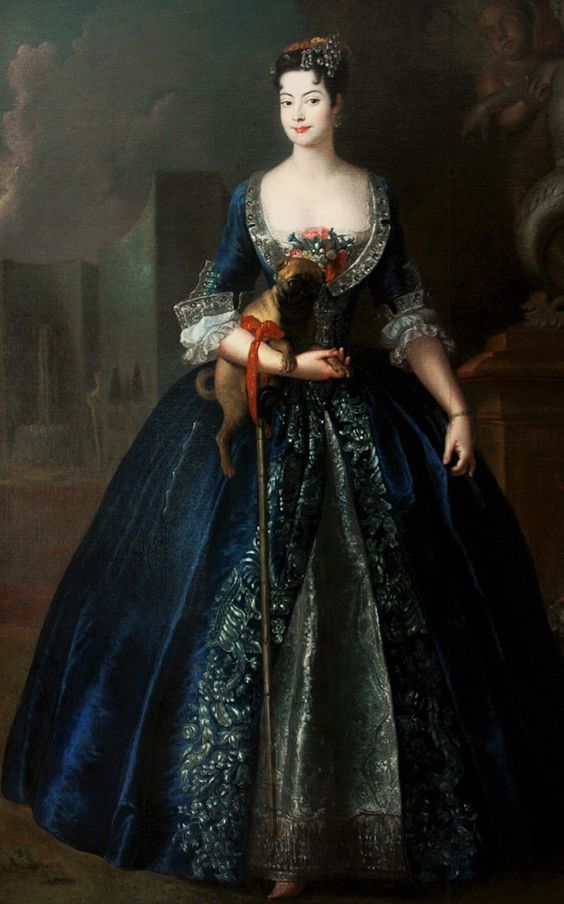
The Rococo neckline never got high, but in the middle of the century it was less low till 1770s when it plunged into new lows. In 1770s the fashion reached a saturation point, when everything was the most. This included boobs. The most boob visible. There was a change in the attitudes though. The visible boob was not a scandal, but it was risque, instead of sing of innocent and did cause offense in certain circles. I think it's because of the French revolution values gaining momentum. I talked about this in length in another post, mostly in context of masculinity, but till that point femininity and masculinity had been mostly reserved for the aristocracy. Gender performance was mostly performance of wealth. The revolutionaries constructed new masculinity and femininity, which laid the groundwork for the modern gender, in opposition to the aristocracy and their decadence. The new femininity was decent, moral and motherly, an early version of the Victorian angel of the house. The boob was present in the revolutionary imagery, but in an abstract presentation. I can't say for sure, but I think bare breasts became indecent because it was specifically fashion of the indecent French aristocracy.
Here's example somewhere from the decade and another from 1778. The neckline stayed quite low for the 1780s, but rose to cover the boobs for the 1790s.

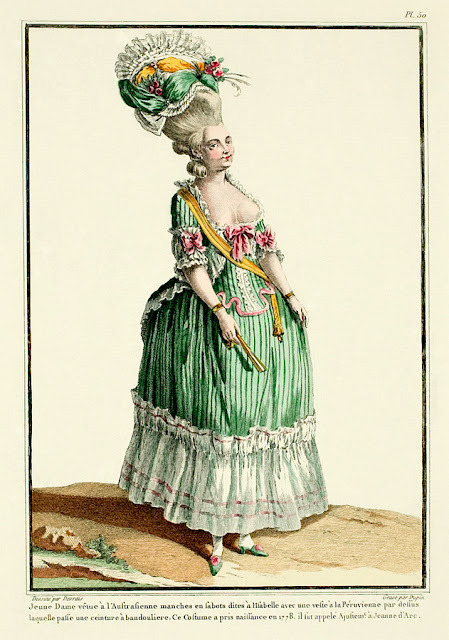
The nipple didn't stay hidden for long but made a quick comeback in the Regency evening fashion. It was somewhat scandalous by this point, and the nipple and sheer fabrics of the Regency fashion gained much scorn and satire. The styles that were in the high danger nip slip territory and those that allowed the nipple to show through fabric, were still quite popular. The sleeves had been mid length for two centuries, but in 1790s they had made a split between evening and day wear. The evening sleeves were tiny, just covering the shoulder. Showing that would have been a little too much. Like a bare boob? A risque choice but fine. A shoulder? Straight to the horny jail. (I'm joking they did have sheer sleeves and sometimes portraits with exposed shoulder.) But long sleeves became the standard part of the day wear. Getting sun was still not acceptable for the same reasonable and unreasonable reasons. Day dresses did also usually have higher necklines or were at least worn with a chemisette to cover the neckline. Fine Indian muslin was a huge trend. It was extremely sheer and used in multiple layers to build up some cover. There were claims that a gust of wind would render the ladies practically naked, though because they were wearing their underclothing including a shift, which certainly wasn't made from the very expensive muslin, I'm guessing this was an exaggeration. Especially though in the first decade, short underboob stays were fairly popular, so combined with a muslin, nipples were seen. Here's an early 1798 example of exactly that. The short stays did disappear eventually, but in 1810s the extremely small bodices did provide nip slip opportunities, as seen in this 1811 fashion plate.
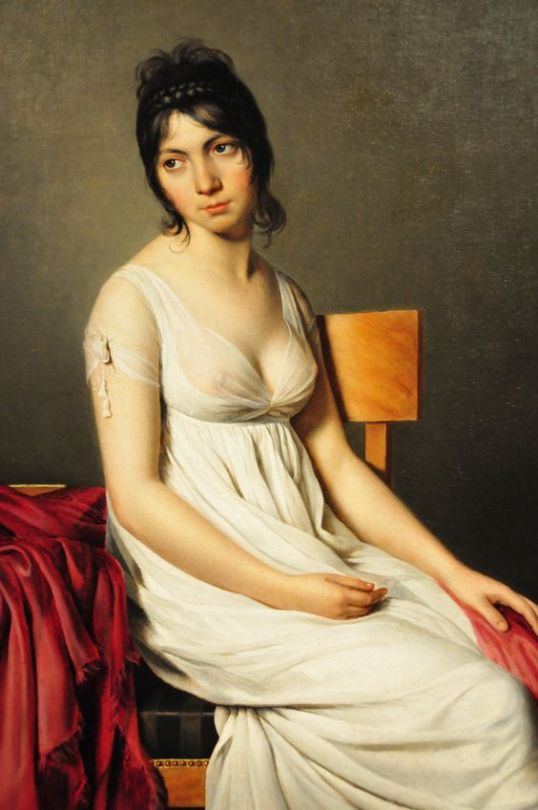
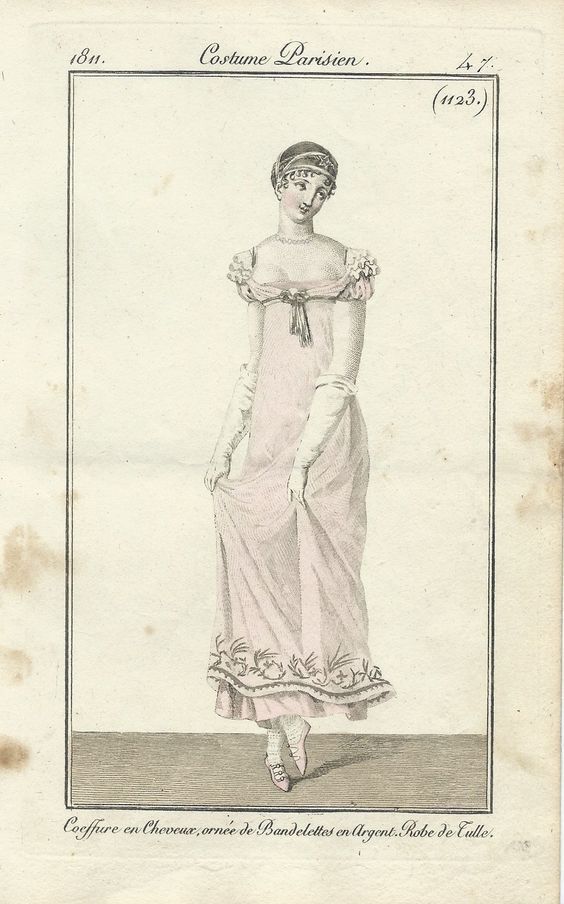
Victorian moralizing did fully kill the nip slip, though at least they were gender neutral about it. The male nipple was just as offensive to them. In 1890s, when bodybuilding became a big thing, bodybuilder men were arrested for public indecency for not wearing a shirt.
#there was also the new femininity aspect to regency nipple which had to do with breastfeeding becoming fashionable among upper class#it's about the whole motherly thing that came with the french revolution#i can't remember the book i read it from so i didn't go into it because i couldn't remember the details lol#but it did definitely have an effect to the fashion and to the perception of nipple#historical fashion#fashion history#history#dress history#fashion#answers#painting#fashion plate#renaissance fashion#elizabethan fashion#rococo fashion#baroque fashion#regency fashion#will tumblr prove itself to be again more prudish than elizabethans and label my post as mature content?#remains to be seen
504 notes
·
View notes
Text
oh, The Female Economy: The Millinery and Dressmaking Trades 1860-1930 (Wendy Gamber, 1997), we're really in it now
#just read this and I love it so much#history#dress history#clothing history#fashion history#women's history#book recs#nonfiction
220 notes
·
View notes
Text

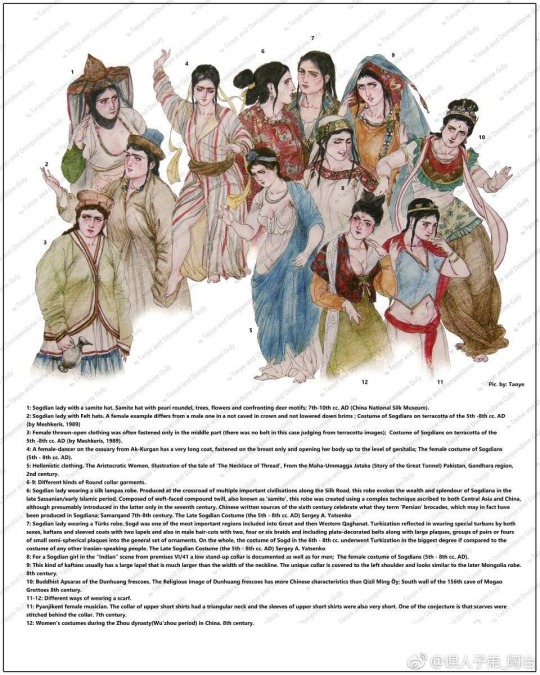

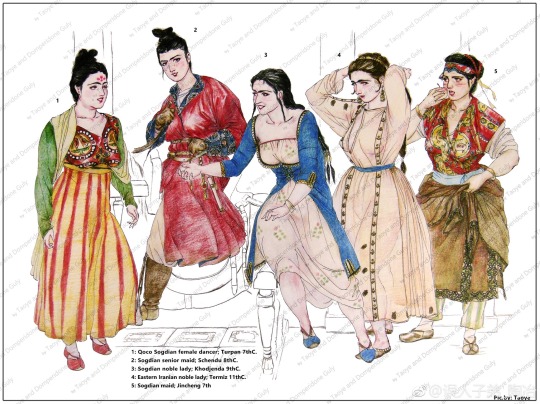
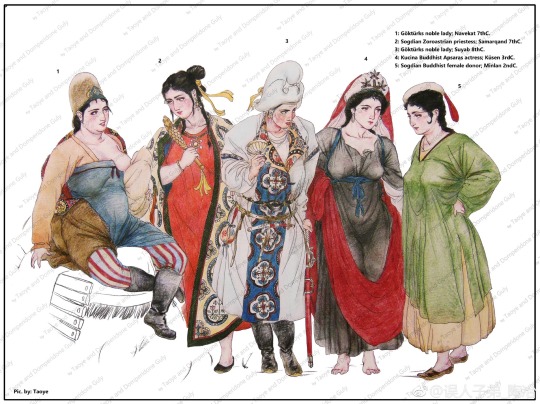


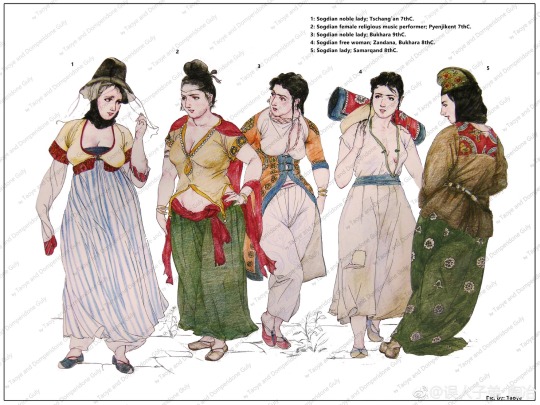
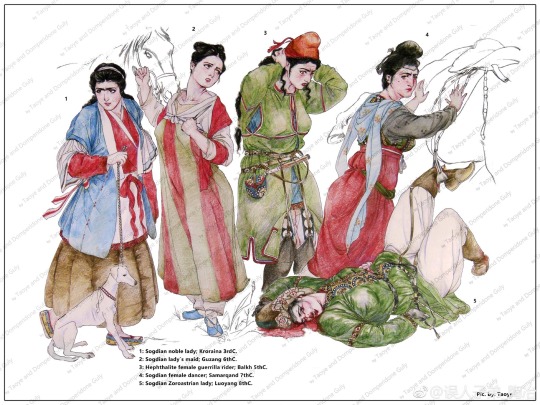
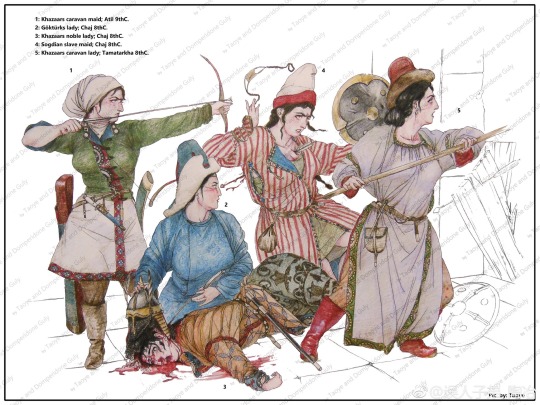
Sogdian Beauty by Taoye & Domperidone Guly. These illustrations are primarily depicting Sogdian women, sometimes in foreign dress. Some of the illustrations depict Hellenic, Hunnic, Tocharian, Turkic, Chinese, Kushan, or misc Iranian dress/people too. Note: Kucina refers to the Kucha (Tocharians).
#sogdiana#historical dress#ancient history#art#art history#fashion history#historical fashion#history#book illustration#book art#historical clothing#clothing#clothes#dresses#women's fashion
237 notes
·
View notes
Text
pt II the wedding dress: crowley's shirt
Dear GOD this post is so overdue I blame the 10khaos. But never fear I'm back on my bullshit.
Okay I'll just add the overview here and then get started on the info-dumping:

THE SHIRT OVERVIEW: For the shirt (which goes under the corset and cummerbund like I described in the pt I post), I went with the basic design sleeve-wise of a typical Victorian-era men's shirt, but with a shorter length (somewhere between a Victorian women's chemisette and the men's shirt). The length is reduced so it doesn't interfere with the silhouette at the waist where the upper part of the dress meets the lower (the lower half hasn't been drawn yet because I got hyperfixated on the cufflinks).
THE NECKLINE AND BODICE: The material would be muslin and it has a Regency-era neckline and bodice, both of these factors inspired by a 1805-1810 Regency muslin evening gown in the Victoria and Albert museum. Regency era gowns typically gathered just under the bust, and so will this shirt, which gives the slight pleats at the bodice below the ruffles. I figured this was best given which parts of the shirt would be visible and which hidden under the corset and jacket.
THE GOOD OMENS ALLUSIONS: The Victorian era is when the Edinburgh minisode happened, which is why I've leaned on it for the shirt. The Regency era, on the other hand, is where most of Jane Austen's novels were set, and so the neckline is a nod to Aziraphale's love for her novels and the ballroom dance he organised in season 2.
For reference, below are (L to R) a Victorian men's shirt, a chemisette, and the neckline and bodice of the V&A Regency dress:

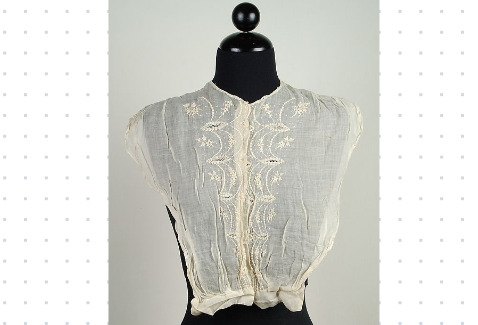

[don't mind the shit images just take the vibes I'm working on a Canva whiteboard and I do NOT keep things organised on there]
Okay I think the ruffles actually need a separate post because I did a lot of overthinking for them. It involved textile trade in the Edwardian era and a lot of lace and Good Omens motifs.
Well... prepare for the ruffles post you poor sods you created a monster.
#weirdly the nightingales wed#good omens mascot#weirdly specific but ok#asmi#good omens#crowley#crowley's wedding dress#the book of love#good omens fandom#maggots#aziraphale#good omens s2#aziracrow#ineffable wedding#ineffable spouses#it starts as it will end with a garden#fashion history#ineffable husbands#ineffable wives#fashion
44 notes
·
View notes
Text



2013 Garrison Day at Fort George, Niagara-on-the-Lake. Black and white photography by Michael Hurley.
#war of 1812#redcoats#canadian history#fort george#british army#1810s#historical reenactment#living history#historical reenactor#dressed to kill#army uniform#flintlock#black powder#food#i appreciate the soldier preparing food#since i have the fort george cook book#military history
56 notes
·
View notes
Text
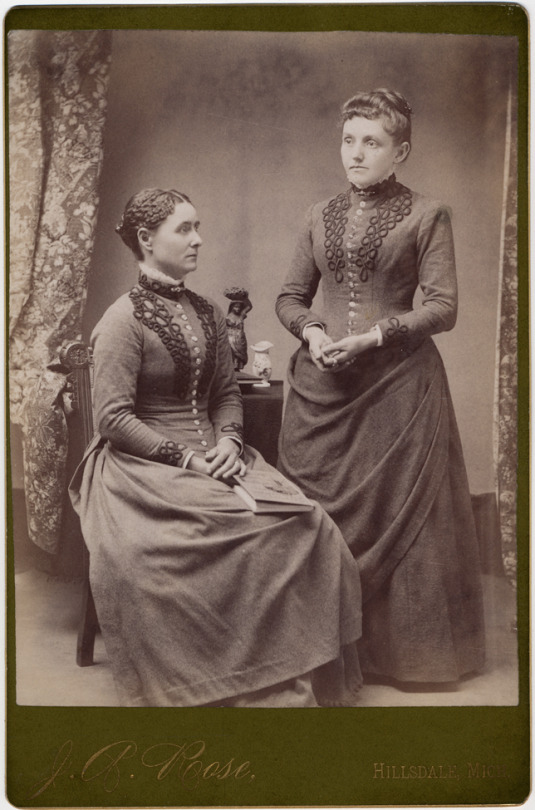
Portrait of two women in princess cut dresses with elaborate cording on the front of the dress and on the sleeve edges, one woman is sitting holding a book and the other woman is standing clasping her hands. Printed on photo front: "J.A. Rose, Hillsdale, Mich."
Burton Historical Collection, Detroit Public Library
#two women#j.a. rose#hillsdale#michigan#michigan history#portrait#portrait photography#vintage#dress#dresses#cording#princess cut#books#cabinet photograph#detroit public library
28 notes
·
View notes
Photo




“Girls of the USSR”, picture book by A. Borisov (1929).
Top to bottom: Samoyed, Ukrainian, Russian.
206 notes
·
View notes
Text

Dress, c.1866.
Silk, linen, cotton.
©️ @cincyartmuseum
#dark academia#light academia#classical#academia aesthetic#escapism#academia#books and libraries#classic literature#books#architecture#object#fashion#historical#history#dress#1800s#19th century#silk#linen#cotton#brown#beautiful#royal core#cottage core#aesthetic#academic#artistic#mood#vibe#tumblr
39 notes
·
View notes
Text

Look at this stuff.... isn't it neat?
I tend to think of Ariel as a museum curator and Belle as the librarian but this dye book would definitely be in Ariel's cavern of wonders. This ombre fabric would make a great little mermaid cosplay look but I still can't get over the fact it's from 1907!
The coal tar colours of Farbwerke vorm. Meister Lucius & Brüning, Hoechst on Main and their application in dyeing cotton and other vegetable fibres. Imprint New York : H. A. Metz, 1907.
104 notes
·
View notes
Text
So on continuation of "researching about a time period for a story no one but me will ever see" I got this book from the library that's about daily life in the Victorian era and it's really cool? Like... Interesting. I doubt I'll use half of this info (I doubt that the story needs a 5 page description of my character getting ready in the morning tbh) but still. And I usually don't read non fiction all that much.
#*.☽ .*boneskullrr*.☽ .*#writing#writers on tumblr#writeblr#writerscommunity#writers#funnily enough there were these (i thiiiink bbc??) documentaries about historians dressing up as ppl from diff eras & living like them for a#while & they'll talk about how ppl did things as they did the same exact thing for the camera which i thought was a really cool way to talk#about history in a way that was engaging. and turns out the author of this book was in those documentaries. i was like 'wait a min' lol#if y'all are curious its 'how to be a victorian: a dawn to dusk guide to victorian life' by ruth goodman
26 notes
·
View notes
Text




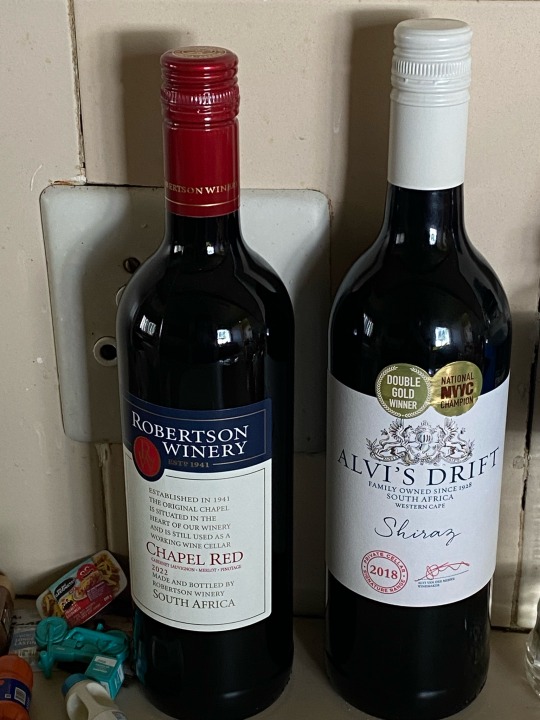


❤️❤️❤️
#classic literature#dark academia#fyodor dostoyevsky#academia#russian literature#dress#otd#dark academia outfit#fit check#books#quotes#aesthetic#divine feminine#coquette#feminine energy#classics#tsh#the secret history#romantic academia#red wine
44 notes
·
View notes
Text
the listening/reading comprehension- where is it?
dress history researchers: corsets and stays are not universal torture devices that render basic physical functionality impossible. most women did not tightlace to extremes in their everyday lives. fiction and pop history distort the realities of those women's lives and how they wore their corsets to play into popular misconceptions partially originated by men both fetishizing and demonizing corsets when they were more common.
some person on the internet: OMG STOP SAYING ALL WOMEN LOVED CORSETS!!! CLEARLY YOU ARE SAYING THAT CORSETS ARE THE BEST THING EVER FOR EVERY WOMAN, AND THAT THEY NEVER HAD ANYTHING TO DO WITH HARMFUL BEAUTY STANDARDS THROUGHOUT ALL OF HISTORY FOREVER AMEN!!!!
#dress history#fashion history#please don't judge current thought in the field by overzealous YouTube comments#that probably are intentional hyperbole anyway#corsets#corset discourse#I'm so sick of it#People Be Normal About Corsets Challenge#(a friend of mine once read a book that had 'banal corsetry' as a selling point on Goodreads)#(ie the corsets are just There and not made much of in either direction)#(thank the gods. more of this please)
186 notes
·
View notes
Text

Costume Parisien. 1806.
Coeffure de Jeune Personne. Robe de Crêpe.
Napoleonic era fashion plate.
#Journal des dames et des modes#fashion plates#fashion history#dress#vintage#vinthae book#robe#mode#modes#historical fashion#history of fashion#Paris#parisian#1800s#1800s fashion#19th century#early 19th century#empire#empire style#first french empire#napoleonic#napoleonic era#french empire#France#history#textiles
82 notes
·
View notes
Link
In light of the 75th Anniversary of the unification of the Dodecanese Islands with the rest of Greece (1948 - 2023), the Hellenic Parliament published a small book with the descriptions and pictures of the women's folk dresses of these islands. It is free and available to read digitally on the parliament's website or for download to your device. It is exclusively in Greek, but people learning Greek could use it for practice or non-speakers can look at the photography, if they are interested. The link is on the top of the post.
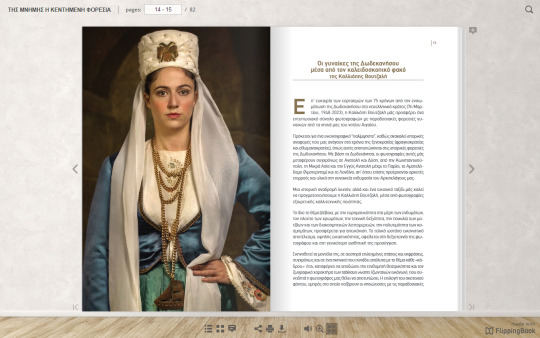
The pictured attire is from Patmos.
#greece#europe#book#free pdf#free books#greek#greek language#historical fashion#traditional clothing#folk clothing#traditional dress#folk dress#dodecanese#patmos#greek islands#greek facts#greek culture#greek history#rec#link
32 notes
·
View notes